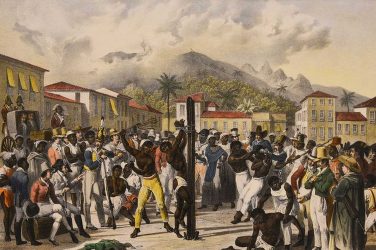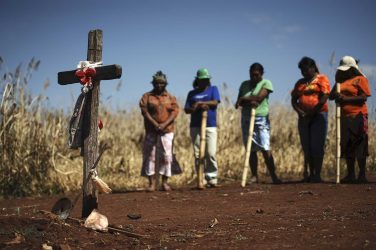In Brazil, a drug program in the northeastern state of Pernambuco has provided some 7,000 marginalized, often homeless crack-cocaine users with housing, health care, psychological support, and job training since 2011 — without requiring that they stop using drugs.
From 2015 to 2016, using both qualitative and quantitative methods (from interviews to data analysis), we undertook an evaluation of Programa Atitude, the state’s five-year-old social outreach program. The study was led by José Luis Ratton, of the Federal University of Pernambuco.
Our study found that the program has both increased health and well-being among Pernambuco’s most vulnerable drug users and reduced violence within this at-risk population — and thus in the state as a whole.
In our opinion, these results support the government’s controversial strategy — which the political right has several times threatened to repeal – to go beyond just arresting people who use drugs to actually help them.
As one drug user in the program said, “We don’t need more prisons. We need aid.”
The results also provide lessons for other cities, both in Brazil and elsewhere, that are struggling to deal effectively with open drug-use scenes.
In Brazil, as across the Americas, people who use drugs openly on the street are often among the poorest, most marginalized in society. This profile holds true in Pernambuco, where our research found that stimulant users are largely poor (84%), black or mixed-race (78.5%) and male (80%), with a little education. They are often homeless, and nearly always unemployed (90%).
This population also faces serious health risks. Among Atitude beneficiaries, HIV is 17 times higher than the Brazilian average (6.7%, versus 0.4%), and 12.8% have syphilis.
Beyond the health harms posed by homelessness and drug use, this population is also highly exposed to violence. Around 96% of Atitude beneficiaries have suffered some kind of violence and 65% had their lives threatened in the last six months. Women were five times more likely to have been abused emotionally or physically.
The program emerged late in the first decade of the 2000s, as Brazil was seeing a sharp uptick in crack consumption – particularly among poor black men.
Other cities, such as São Paulo, responded with New York City-style violent police crackdowns in communities where drugs were openly consumed.
Many cities here still respond to any narcotics activity with intense law enforcement. For example, Rio de Janeiro’s SWAT-style Police Pacification program has heavily armed officers essentially occupying favelas and arresting, sometimes killing, people they identify as “traffickers”.
Pernambuco was not a total exception. One Atitude beneficiary told us that the police “would grab us in the river bed and beat us for no reason, only because we were drug users.”
But in Pernambuco, a pioneer in mental health reforms, policymakers also understood that given the nature of illicit markets and the profile of crack users, arrests alone could not solve the problem.
By 2007, Pernambuco’s murder rate was double the Brazilian average, at 54 per 100,000, and Recife had become Brazil’s third-most dangerous capital.
So in 2007 the state launched the Pact for Life, a violence-prevention initiative, that incorporated elements of Boston’s successful Operation Ceasefire. That helped homicides decrease 40% from 2007 to 2013, back to 1980s levels.
Pernambuco next recognized that a considerable portion of its murder victims were also drug users, killed by dealers to whom they owed money or victims of generalized gang-related street violence in poor neighborhoods.
In other words, drug users were part of the state’s homicide epidemic. So in 2010 the government added US$ 1.5 million to Pact for Life for a one-year pilot program to protect this vulnerable community.
According to our evaluation, 77.2% of beneficiaries spoke about feeling safer in the program, which can provide them with temporary housing safely removed from their own risky neighborhoods if necessary.
This finding, while not conclusive, suggests that some crime in violent communities can be prevented not by aggressive policing — a strategy that’s caused resentment in both New York and Brazil — but with social services.
Another useful finding is that after completing Programa Atitude, people tended to smoke less crack. The number of people who smoked 15 or more rocks at a time decreased from 57% to 24.8%. Daily consumption dropped from 82.1% to 22.1%. And 35.6% claimed to have stopped using drugs entirely.
Our findings support a growing body of research from cities across the Americas that have sought to deal with violence and drug use in more humane ways, which shows that stability, health and connectivity can make people feel less need to get high.
By supporting people to get a job, rebuild family ties, stick with therapy, and update legal documents, social-inclusion programs help drug users do the basic things necessary for a satisfying, sustainable life.
“I was very skinny,” one participant told us. “I began to gain weight. I ate. [I began] to sleep well.”
This outcome demonstrates why policymakers must move beyond the binary of seeing drugs as either a criminal problem or a health issue. Drug use is a complex phenomenon that requires complex responses.
Considering the social determinants of health (income, employment, race and gender, among other things), and not insisting on abstinence as a prerequisite for getting help is the foundation of other harm-reduction initiatives.
New York’s Pathways Housing First, for example, provides housing to homeless drug users on the basis that stability — a mailing address, a bed — is a necessary first step for people to make other positive changes, such as finding employment.
More recently, under its previous mayor, São Paulo implemented the Programa de Braços Abertos – “Open Arms” — which provides housing, employment, food, and social services to homeless drug users in the city’s so-called “Crackland”.
Brazil’s Conservative Backlash
But harm-reduction programs, among other social policies, are endangered by Brazil’s rightward tilt and economic crisis.
Conservatives in power seek to replace the harm-reduction initiatives now operating in Brazil with outdated models that have been proven ineffective.
Drug treatment in Brazil — and indeed in many Latin American countries — often consists of compulsory hospitalization or lengthy interments in faith-based “therapeutic communities”.
Evidence shows that coerced, abstinence-based rehab rarely helps addiction, and may actually violate users’ human rights.
As one person who’d been through religious “treatment” asserted, “I don’t want to become evangelical, I want to get rid of the addiction.”
However, this approach to addiction continues to be pushed in Brazil.
The Atitude program is not perfect. Our study found insufficient follow-up with program graduates, uneven coordination among the government entities that operate it and chronic under-funding. Some of these problems are locally rooted, and others are endemic to Brazilian government programs. Many are fixable.
And even in a challenging place like Brazil today — with its economic and political crises — human-centered programs are a relatively affordable and proven effective way to help society’s most vulnerable people, keep them safe and, as a result, improve overall community well-being.
Will Brazilian leaders pay attention to the evidence?
Rafael West is a researcher at Universidade Federal de Pernambuco. West works with the National Secretary of Drugs in Brazil and also with the Fundação Oswaldo Cruz.
Arturo Escobar is a research scholar for the Study Group on Alcohol and Other Drugs, Universidade Federal de Pernambuco. Escobar works for the Executive Secretary on Drug Policy of the State of Pernambuco. He is also affiliated with Antiprohibitionist Collective of Pernambuco.
The research cited here was funded by the Open Society Foundations.
This article was originally published on The Conversation. Read the original article here: https://theconversation.com/why-cities-should-stop-arresting-crack-users-and-help-them-instead-67828














